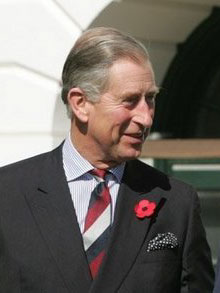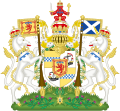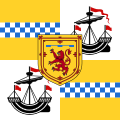Duke of Rothesay
Duke of Rothesay ( English Duke of Rothesay , Scottish Gaelic Diùc Baile Bhòid ) is a British noble title in the Peerage of Scotland , which is named after Rothesay Castle on the Isle of Bute . He was the official title of Heir Apparent to the Scottish throne. Since the Act of Union 1707 , the title has been given to the respective heirs of Great Britain or the United Kingdom . When used in Scotland, it has priority over its titles " Duke of Cornwall " and " Prince of Wales ".
The title has been associated with that of the Duke of Cornwall since 1603 . Unlike the English title of the Duke of Cornwall, the title of the Duke of Rothesay ("dukedom") is not associated with land ownership in the form of a duchy ("duchy").
The current holder of the title is the heir to the throne, Prince Charles . His wife, Camilla , thus bears the courtesy title “Duchess of Rothesay”.
Awards
The title was first used on April 28, 1398 by King Robert III. bestowed on his eldest son David . David had been heir to the Scottish throne since 1390, but died in 1402 before he could ascend the throne. In 1404 the title was re-created for his younger brother James , it expired in 1406 when James I became King of Scotland and the title merged with the crown. On October 16, 1430, Jacob I bestowed the title on his newborn son Alexander , who died on the same day, making the title void again. In 1431 at the latest, the title was bestowed on his younger twin brother James , who became King of Scotland as James II in 1437, whereby the title merged again with the crown. In the fifth award, the title was recreated on July 20, 1451 for his son James , who was crowned as Jacob III in 1460. Became King of Scotland. Since the unification of the Kingdoms of Scotland and England in the Act of Union 1707 to form the Kingdom of Great Britain, the regulation has continued to apply to the British heir to the throne as the legal successor to the Scottish heir to the throne.
Although until then it was formally conferred as a hereditary title, it was in fact only ever carried by the heir to the throne. In 1469, the Scottish Parliament confirmed this tradition and passed a law that stipulated that the king's firstborn son and heir should hold the title. Due to this regulation, the title cannot be inherited. Thus, if the first-born prince dies before the king, the title does not pass to his or her eldest son, although the latter would then be heir to the throne because he would not be the king's “son”. Formally, this non-hereditary title is considered to have been created in the Peerage of Scotland in 1469 - it is thus the oldest still existing duke title of this peerage and is also superior to the other dukes in terms of protocol ranking because its respective holder is always a member of the royal family .
Subordinate title
The current Duke of Rothesay is also the holder of the subordinate titles Earl of Carrick , Baron of Renfrew, Lord of the Isles and Prince and Great Steward of Scotland , for which essentially the same succession rules apply as for the Duke title.
heraldry
The coat of arms of the Duke of Rothesay shows the coat of arms of the Great Steward of Scotland at the top right and bottom left and the coat of arms of the Lord of the Isles at the top left and bottom right (always viewed from the perspective of the person wearing the escutcheon, i.e. from behind). In the middle is the coat of arms of the Scottish Crown Prince (the coat of arms of Scotland with a tournament collar ).
Banner of the Duke of Rothesay
Standard of the Duke of Rothesay (the flag of the Scottish King ("Lion rampant") with a tournament collar)
List of the Dukes of Rothesay
Dukes of Rothesay, hereditary awards
Duke of Rothesay, first bestowed (1398)
- David Stewart, Duke of Rothesay (1378-1402)
Duke of Rothesay, second award (1404)
- James Stewart, Duke of Rothesay (1394-1437); Crowned as James I of Scotland in 1406
Duke of Rothesay, third bestowal (1430)
- Alexander Stewart, Duke of Rothesay (1430-1430)
Duke of Rothesay, fourth award (1431)
- James Stewart, Duke of Rothesay (1430-1460); Crowned as James II of Scotland in 1437
Duke of Rothesay, fifth award (1452)
- James Stewart, Duke of Rothesay (1451 / 52-1488); Crowned as Jacob III in 1460 of Scotland
Duke of Rothesay, non-hereditary bestowal (1469)
- 1473-1488: James Stewart, Duke of Rothesay (1473-1513); Crowned as James IV of Scotland in 1488
- 1507–1508: James Stewart, Duke of Rothesay (1507–1508)
- 1509–1510: Arthur Stewart, Duke of Rothesay (1509–1510)
- 1512-1513: James Stewart, Duke of Rothesay (1512-1542); Crowned as James V of Scotland in 1513
- 1540–1541: James Stewart, Duke of Rothesay (1540–1541)
- 1566-1567: James Stewart, Duke of Rothesay (1566-1625); Crowned as Jacob VI in 1567 of Scotland (1603 also called James I of England)
- 1594–1612: Henry Frederick, Prince of Wales , Duke of Cornwall, Duke of Rothesay (1594–1612)
- 1612-1625: Charles, Prince of Wales , Duke of Albany, Duke of Cornwall, Duke of Rothesay, Duke of York (1600-1649); Crowned as Charles I of England and Scotland in 1625
- 1629–1629: Charles James, Duke of Cornwall , Duke of Rothesay (1629–1629)
- 1630-1649: Charles, Prince of Wales , Duke of Cornwall, Duke of Rothesay (1630-1685); Crowned as Charles II of England and Scotland in 1649
- 1688-1702: James, Prince of Wales , Duke of Cornwall, Duke of Rothesay (1688-1766); Title 1702 formally revoked
- 1714-1727: George, Prince of Wales , Duke of Cambridge, Duke of Cornwall, Duke of Rothesay (1683-1760); Crowned as George II of Great Britain in 1727
- 1727–1751: Frederick, Prince of Wales , Duke of Cambridge, Duke of Cornwall, Duke of Edinburgh, Duke of Rothesay (1707–1751)
- 1762-1820: George, Prince of Wales , Duke of Cornwall, Duke of Rothesay (1762-1830); Crowned as George IV of the United Kingdom in 1820
- 1841-1901: Albert, Prince of Wales , Duke of Cornwall, Duke of Rothesay (1841-1910); Crowned as Edward VII in 1901 (United Kingdom)
- 1901-1910: Georg, Prince of Wales , Duke of Cornwall, Duke of Rothesay, Duke of York (1865-1936); Crowned as George V of the United Kingdom in 1910
- 1910-1936: Edward, Prince of Wales , Duke of Cornwall, Duke of Rothesay (1894-1972); Crowned Edward VIII of the United Kingdom in 1936
- 1952 – today: Charles, Prince of Wales , Duke of Cornwall, Duke of Rothesay (* 1948)
Individual evidence
- ^ Charles Kidd, David Williamson: Debrett's Peerage and Baronetage. With Her Majesty's Royal Warrant Holders. Debrett's Peerage Ltd., New York 1990, ISBN 0312046405 , p. 48.



